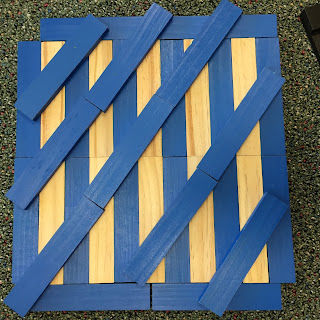"Every child has a different learning style and pace. Each child is unique, not only capable of learning but also capable of succeeding.
- Robert John Meehan
Many people believe that Kindergarten students are unable to grapple with complex mathematical ideas. This is not true. Kindergarten students are capable of exploring mathematical ideas when it is done through play and is initiated by their ideas and interests. As educators, we need to be listening, watching, questioning and prompting as they explore.
A group of Year 2 students were using cuisinaire rods (a math manipulative) to create the solar system. They ensured that the sun was yellow, Earth was green and blue and all the other planets were accurate. They then wrote about their creation, sticking mostly to science understanding and sharing their learning from our space inquiry.
 |
| The initial creation. |
We prompted them to count how many cubes were in each planet they created. As the cuisinaire rods are grouped together, they could not separate them to count one by one. We worked on using different counting strategies- counting by 10s, using friendly numbers and counting on. They recorded the totals on sticky notes. As the educators, this was our goal- building math strategies to count larger numbers of objects. But, what unfolded next was because of these mathematicians thinking critically about their work and their knowledge about planets.
 |
The final version.
(You can see the changes to the total number of cubes in each planet after they problem solved the size issues for each planet. The sun is on the right and Neptune on the left) |
After they added the totals to each planet they noticed a problem, which led to some very complex math and science thinking. We'll let you hear it from them. We have transcribed the conversation with the students explaining their problem solving:
What did you do first?
D.S- We made the solar system and then we counted them and we wrote the numbers
What was the first problem?
D.S- First Jupiter was smaller than Neptune
What did you do?
I.S- I took 30 blocks away from Neptune to make it smaller
D.S- I made 2 more for Jupiter to make it bigger (she added two rows to each side of their initial 'Jupiter' creation)
But that made a new problem...
P.W- And then the sun was smaller, so we all made the sun bigger
Then you noticed two other problems...
J.C- So when I came, Saturn was thin then I made it thicker and then I saw that Venus is supposed to be the same size as Earth, but we did Mars as the same size as Earth. So we changed it so Venus is the same as Earth.
Which was the smallest?
All- Mercury!
And is Mercury the smallest planet in the solar system?
All- Yes!
What happened when you added more cubes to Saturn?
J.C- It's the second biggest planet
Which is the biggest in the solar system?
P.W- The sun!
How many cubes was the sun?
D.S- 70!
At first it was, but then you made it bigger. How many did it have after?
All- 140!
As you can see, these mathematicians were thinking about so many different concepts during this play experience. Using Cathy Fosnot's math landscape, you can see they have begun to use a variety of strategies and explore and use a number of different mathematical concepts and skills.
They combined their learning about the planets with their understanding of quantity and size.
Give your students (or your child) the chance to experiment with complex math through play. Provide open ended materials that encourage a variety of play, but most importantly...believe they are capable, listen to their ideas and challenge them to think critically about their creations.

















































